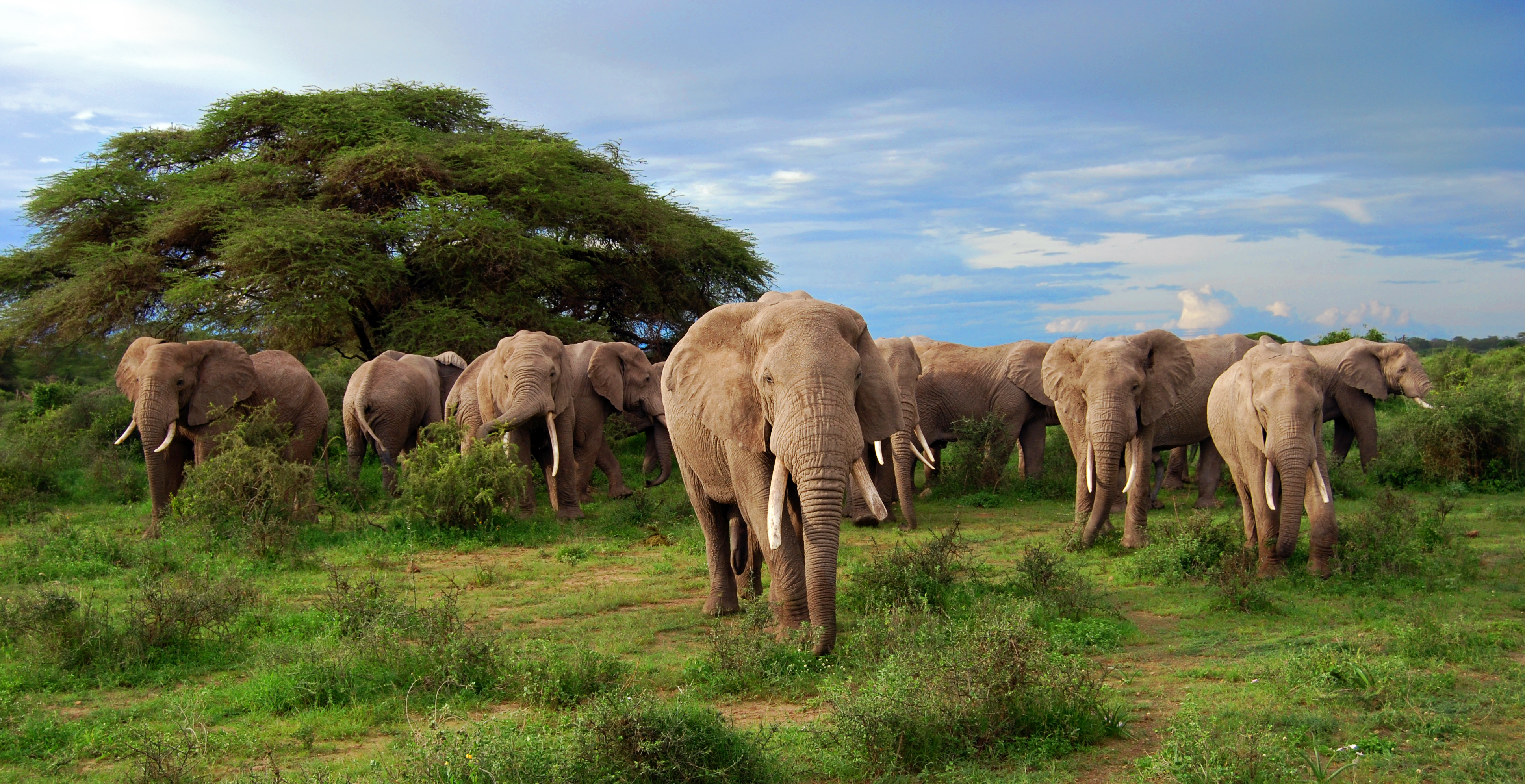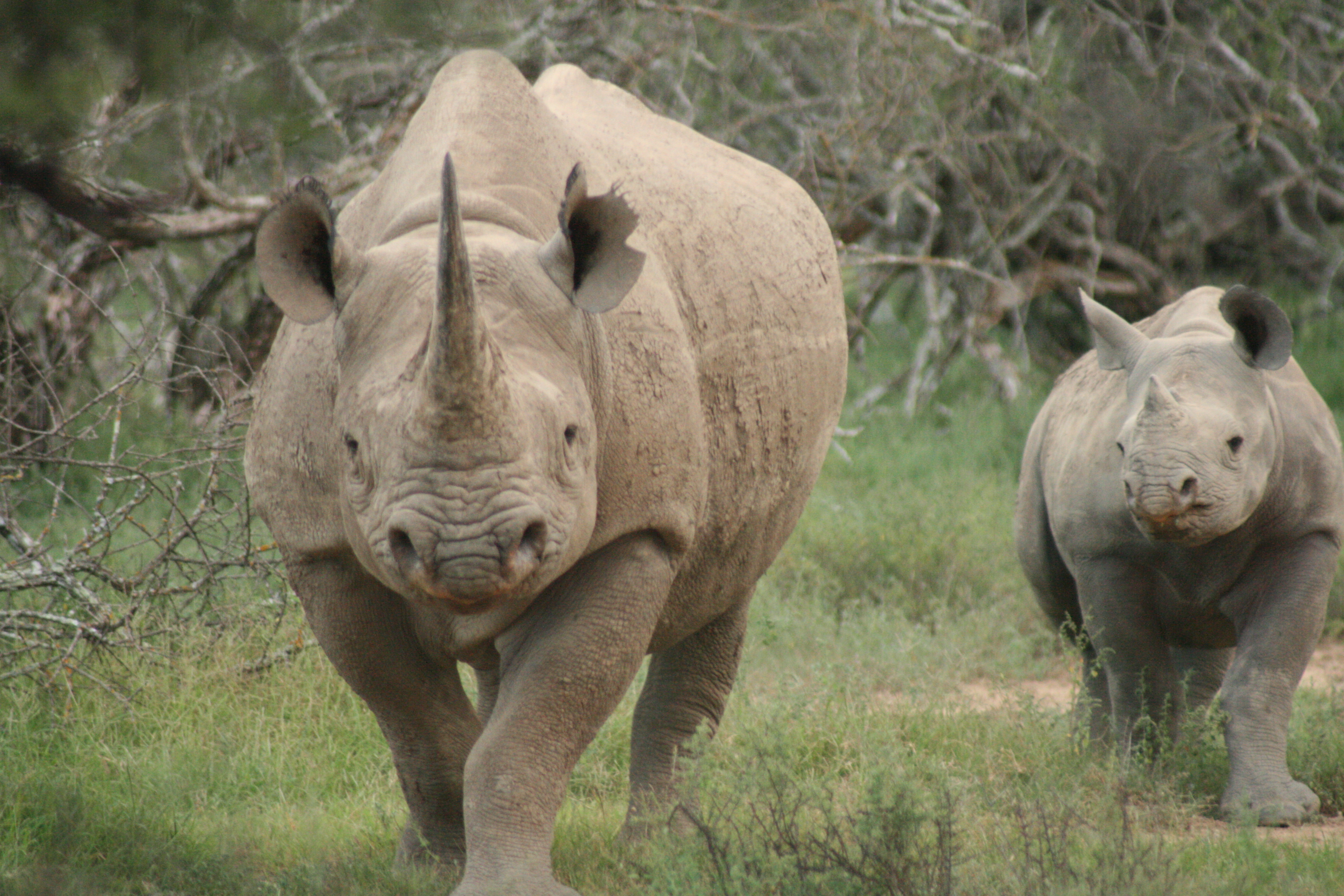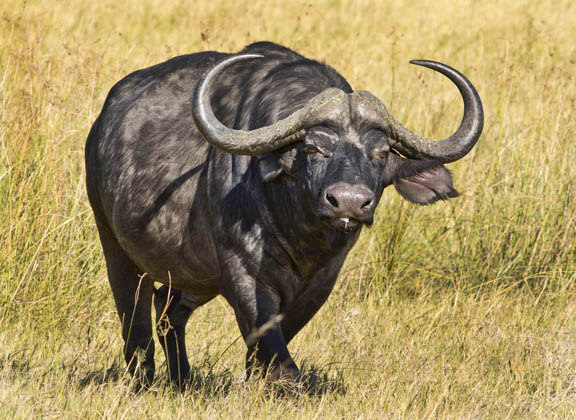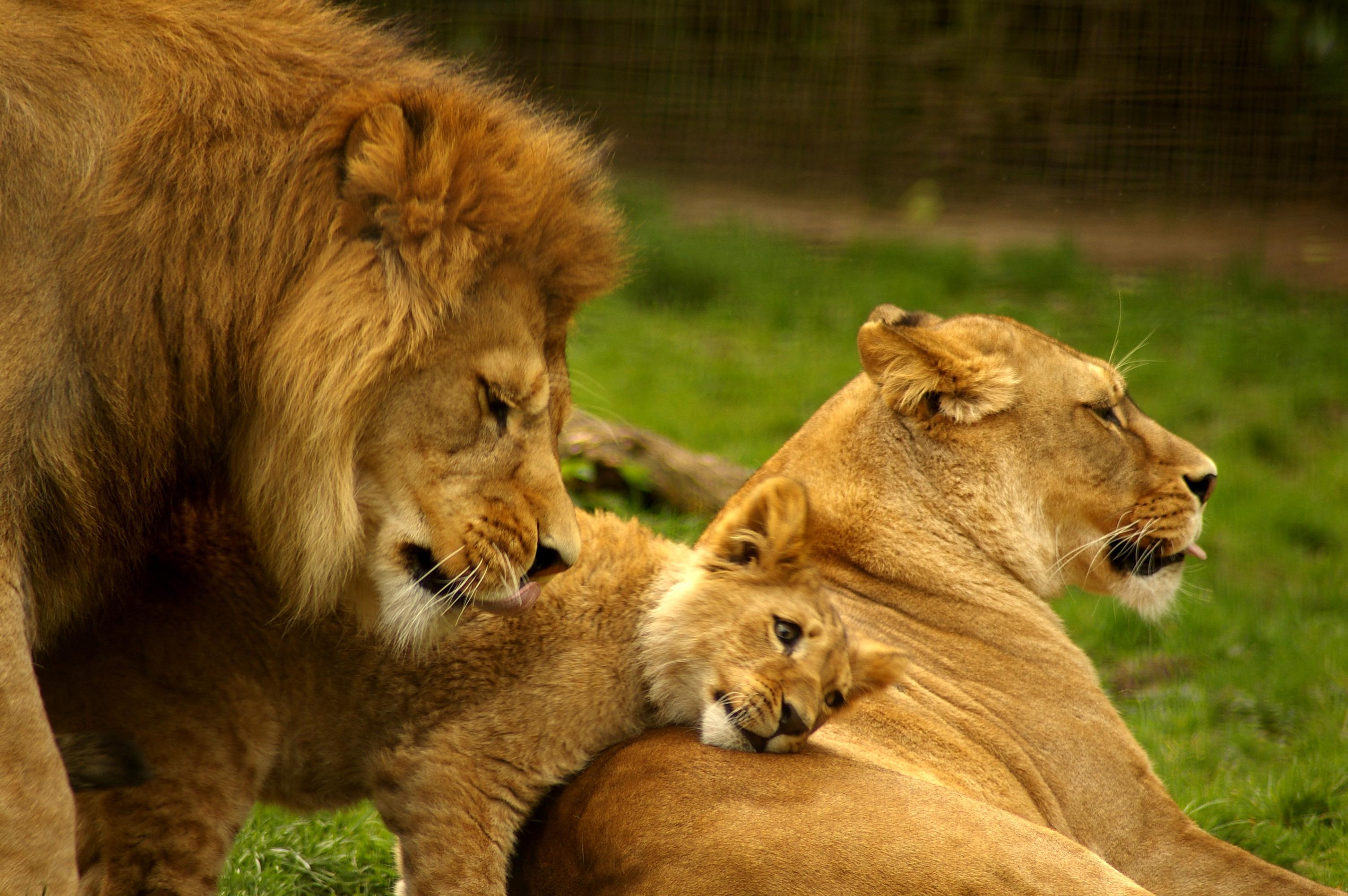In Africa, the Big Five of Africa are the African lion, African elephant, Cape buffalo, African leopard, and Black rhinoceros. The term “Big Five” was coined by big-game hunters and refers to the five most difficult animals in Africa to hunt on foot. The members of the Big Five were chosen for the difficulty in hunting them and the degree of danger involved, rather than their size. They are among the most dangerous.
Countries where all the members of the big five can be found include Kenya, Tanzania, Botswana, Namibia, South Africa and Zimbabwe.
African Bush elephant (Loxodonta africana)
African elephants are of the genus Loxodonta (from the Greek words loxo (oblique sided) and donta (tooth). The genus consists of two extant species: the African bush elephant and the smaller African forest elephant. Loxodonta is one of two existing genera of the family, Elephantidae. Fossil remains of Loxodonta have been found only in Africa.
The bush elephant is the largest living terrestrial animal, while the forest elephant is the third largest. Their thickset bodies rest on stocky legs, and they have concave backs. Their large ears enable heat loss. The upper lip and nose form a trunk. The trunk acts as a fifth limb, a sound amplifier, and an important method of touch. African elephants’ trunks end in two opposing lips, whereas the Asian elephant trunk ends in a single lip. Loxodonta africana, males stand 3.2–4.0 meters tall at the shoulder and weigh 4.7 tonnes – 6.0 tonnes while females stand 2.2–2.6 meters tall and weigh 2.1 tonnes –3.2 tonnes .The largest recorded individual stood four metres at the shoulders and weighed 10 tonnes.
The Teeth
Elephants have four molars; each weighs about 5 kg (11 lb) and measures about 30 cm (12 in) long. As the front pair wears down and drops out in pieces, the back pair moves forward, and two new molars emerge in the back of the mouth. Elephants replace their teeth four to six times in their lifetime. At about 40 to 60 years of age, the elephant no longer has teeth and will likely die of starvation, a common cause of death. African elephants have 24 teeth total – Six on each quadrant of the jaw. The enamel plates of the molars are fewer in number than in Asian elephants.
The Tusks
The elephants’ tusks are firm teeth; the second set of incisors becomes the tusks. They are used for digging for roots and stripping the bark from trees for food; for fighting each other during mating season; and for defending themselves against predators. The tusks weigh from 23–45 kg (51–99 lb) and can be from 1.5–2.4 m (5–8 ft) long. Unlike Asian elephants, both male and female African elephants have tusks. They are curved forward and continue to grow throughout the elephant’s lifetime.
Behaviour
African elephant societies are arranged around family units. Each family unit is made up of around ten closely related females and their calves and is led by an older female known as the matriarch. When separate family units bond, they form kinship or bond groups. After puberty, male elephants tend to form alliances with other males.
Elephants are at their most fertile between the ages of 25 and 45. Calves are born after a gestation period of nearly two years. The calves are cared for by their mother and other young females in the group, known as allomothers.
Elephants use some vocalizations that are beyond the hearing range of humans, to communicate across large distances. Elephant mating rituals include the gentle entwining of trunks.
Feeding
While feeding, elephants use their trunks to pluck at leaves and their tusks to tear at branches, which can cause enormous damage to foliage. African elephants may eat up to 450 kilograms (992 lb) of vegetation per day. Only 40 percent of this food is properly digested.
Intelligence
African elephants are highly intelligent, a trait they share with humans, apes and some dolphin species. They are amongst the world’s most intelligent species. The elephant’s brain is similar to that of humans in terms of structure and complexity. Elephants exhibit a wide variety of behaviours, including those associated with grief, learning, allomothering, mimicry, art, play, a sense of humor, altruism, use of tools, compassion, cooperation, self-awareness, memory and possibly language – all point to a highly intelligent species that is thought to be equal with cetaceans.
Reproduction
African elephants show sexual dimorphism by age 20. By age 25 males are double the weight of females due to the rapid early growth of males. Female African elephants are able to start reproducing at around 10 to 12 years of age and are in estrus for about 2 to 7 days. They do not mate at a specific time; however, they are less likely to reproduce in times of drought than when water is plentiful. The gestation period of an elephant is 22 months and fertile females usually give birth every 3 – 6 years, so if they live to around 50 years of age, they may produce 7 offspring. Females are a scarce and mobile resource for the males so there is intense competition to gain access to estrous females.
Males usually stay with a female and her herd for only a few weeks before moving on in search for another mate. Less than a third of the population of female elephants will be in estrus at any given time and gestation period of an elephant is long, so it makes more evolutionary sense for a male to search for as many females as possible rather than stay with one group.
Black rhinoceros (Diceros Bicornis)
The black rhinoceros or hook-lipped rhinoceros is a species of rhinoceros, native to eastern and central Africa including Kenya, Tanzania, Cameroon, South Africa, Namibia, Zimbabwe, and Angola. Although the rhinoceros is referred to as black, its colours vary from brown to grey.
The other African rhinoceros is the white rhinoceros (Ceratotherium simum). The word “white” in the name “white rhinoceros” is often said to be a misinterpretation of the Afrikaans word wyd (Dutch wijd) meaning wide, referring to its square upper lip, as opposed to the pointed or hooked lip of the black rhinoceros. These species are sometimes referred to as the square-lipped (for white) or hook-lipped (for black) rhinoceros.
Description
An adult black rhinoceros stands 140–180 cm high at the shoulder and is 3–3.75 in length. An adult typically weighs from 800 to 1,400 kg however unusually large male specimens have been reported at up to 2,199–2,896 kg. The females are smaller than the males. Two horns on the skull are made of keratin with the larger front horn typically 50 cm (20 in) long, exceptionally up to 140 cm (55 in).
Behaviour
Black rhinoceros are generally solitary, with the only strong bond between a mother and her calf. In addition, males and females have a consort relationship during mating, also sub-adults and young adults frequently form loose associations with older individuals of either sex. They are not very territorial and often intersect other rhino territories. Home ranges vary depending on season and the availability of food and water. Generally they have smaller home ranges and larger density in habitats that have plenty of food and water available and vice versa if resources are not readily available.
Studies have shown that males sleep longer on average than females by nearly double the time. Other factors that play a role in their sleeping patterns is the location of where they decide to sleep. The black rhinos are extremely aggressive, and charges readily at perceived threats. Black rhinos fight each other, and they have the highest rates of mortal combat recorded for any mammal: about 50% of males and 30% of females die from combat-related injuries. Adult rhinos normally have no natural predators, thanks to their imposing size as well as their thick skin and deadly horns. However, adult black rhinos have fallen prey to crocodiles in exceptional circumstances. Calves and, very seldom, small sub-adults may be preyed upon by lions as well. Black rhinoceros are very fast and can get up to speeds of 55 kilometres per hour (34 mph) running on their toes.
Diet
The black rhinoceros is a herbivorous browser that eats leafy plants, branches, shoots, thorny wood bushes, and fruit. They browse for food in the morning and evening. They are selective browsers but, studies done in Kenya show that they do add the selection material with availability in order to satisfy their nutritional requirements. In the hottest part of the day they are most inactive- resting, sleeping, and wallowing in mud. Wallowing helps cool down body temperature during the day and protects against parasites. When black rhinos browse they use their lips to strip the branches of their leaves. Competition with elephants is causing the black rhinoceros to shift its diet. The black rhinoceros alters its selectivity with the absence of the elephant.
There is some variance in the exact chemical composition of rhinoceros horns. This variation is directly linked to diet and can be used as a means of rhino identification. Horn composition has helped scientists pinpoint the original location of individual rhinos, allowing for law enforcement to more accurately and more frequently identify and penalize poachers.
Communication
Rhinos use several forms of communication. Due to their bad eyesight and solitary nature, scent marking is often used to identify themselves to other black rhinos. Females’ urine spray more often when receptive for breeding. Defecation sometimes occurs in the same spot used by different rhinos, such as around feeding stations and watering tracks. Coming upon these spots, rhinos will smell to see who is in the area and add their own marking. When presented with adult faeces, male and female rhinoceroses respond differently than when they are presented with sub-adult faeces. The urine and faeces of one black rhinoceros helps other black rhinoceroses to determine its age, sex, and identity. Less commonly they will rub their heads or horns against tree trunks to scent-mark.
To compensate for its poor eyesight, the black rhino has powerful tube-shaped ears that can freely rotate in all directions. This highly developed sense of hearing allows black rhinos to detect sound over vast distances.
Reproduction
The adults are solitary in nature, coming together only for mating. Mating does not have a seasonal pattern but births tend to be towards the end of the rainy season in more arid environments.
When in season the females will mark dung piles. Males will follow females when they are in season; when she defecates he will scrape and spread the dung, making it more difficult for rival adult males to pick up her scent trail.
Courtship behaviors before mating include snorting and sparring with the horns among males. They also bluff and bluster, where the rhino will snort and swing its head from side to side aggressively before running away repeatedly. Breeding pairs stay together for 2–3 days and sometimes even weeks. They mate several times a day over this time and copulation lasts for a half-hour.
The gestation period is 15 to 16 months. The single calf weighs about 35–50 kilograms at birth, and can follow its mother around after just three days. Weaning occurs at around 2 years of age for the offspring. The mother and calf stay together for 2–3 years until the next calf is born; female calves may stay longer, forming small groups. The young are occasionally taken by hyenas and lions. Sexual maturity is reached from 5 to 7 years old for females, and 7 to 8 years for males. The life expectancy in natural conditions (without poaching pressure) is from 35 to 50 years.
African Cape buffalo
The African buffalo or Cape buffalo (Syncerus caffer), is a very robust species. Its shoulder height can range from 1 to 1.7 meters and its head-and-body length can range from 1.7 to 3.4 meters. Savannah-type buffaloes weigh 500 to 900 kg, with males normally larger than females, reaching the upper weight range. In comparison, forest-type buffaloes, at 250 to 450 kg are only half that size. Its head is carried low; its top is located below the backline. The front hooves of the buffalo are wider than the rear, which is associated with the need to support the weight of the front part of the body, which is heavier and more powerful than the back.
Savannah-type buffaloes have black or dark brown coats with age. Old bulls have whitish circles around their eyes. Females tend to have more-reddish coats. Forest-type buffaloes are reddish brown in colour with horns that curve back and slightly up. Calves of both types have red coats.
A characteristic feature of the horns of adult male African buffalo is fusion of their bases, forming a continuous bone shield referred to as a “boss”. From the base, the horns diverge downwards, then smoothly curve upwards and outwards. In large bulls, the distance between the ends of the horns can reach upwards of one metre. The horns form fully when the animal reaches the age of five or six years. In cows, the horns are, on average, 10–20% smaller, and the boss is less prominent. Forest buffalo horns are smaller than those of the savannah buffalo, usually measuring less than 40 centimetres, and are almost never fused.
Ecology
The African buffalo is one of the most successful grazers in Africa. It lives in swamps and floodplains, as well as mopane grasslands and forests of the major mountains of Africa. This buffalo prefers habitat with dense cover, such as reeds and thickets, but can also be found in open woodland..
Other than humans, African Cape buffaloes have few predators and are capable of defending themselves against (and killing) lions. Lions do kill and eat buffalo regularly, and in some regions, the buffaloes are the lions’ primary prey. It typically takes several lions to bring down a single adult buffalo; however, several incidents have been reported in which lone adult male lions have been able to successfully bring down adult animals. The Nile crocodile attack old solitary animals and young calves, though they can kill healthy adults. The cheetah, leopard and spotted hyena are a threat only to new-born calves, though spotted hyenas have been recorded killing full grown bulls on rare occasions.
Social behaviour
Herd size is highly variable. The core of the herds is made up of related females, and their offspring, in an almost linear dominance hierarchy. The basic herds are surrounded by sub-herds of subordinate males, high-ranking males and females and old or invalid animals.]
Vocalizations
African buffaloes make various vocalizations. Many calls are lower-pitched versions of those emitted by domestic cattle. They emit low-pitched, two- to four-second calls intermittently at three- to six-second intervals to signal the herd to move. To signal to the herd to change direction, leaders will emit “gritty”, “creaking gate” sounds. When moving to drinking places, some individuals make long maaa calls up to 20 times a minute. When being aggressive, they make explosive grunts that may last long or turn into rumbling growl. Cows produce croaking calls when looking for their calves. Calves will make a similar call of a higher pitch when in distress. When threatened by predators, they make drawn-out waaaa calls. Dominant individuals make calls to announce their presence and location. A more intense version of the same call is emitted as a warning to an encroaching inferior. When grazing, they will make various sounds, such as brief bellows, grunts, honks and croaks.
Reproduction
Buffaloes mate and give birth only during the rainy seasons. Birth peak takes place early in the season, while mating peaks later. A bull will closely guard a cow that comes into heat, while keeping other bulls at bay. This is difficult, as cows are quite evasive and attract many males to the scene. By the time a cow is in full estrus, only the most dominant bull in the herd/sub-herd is there.
Cows first calve at five years of age, after a gestation period of 11.5 months. New-born calves remain hidden in vegetation for the first few weeks while being nursed occasionally by the mother before joining the main herd. Older calves are held in the centre of the herd for safety. The maternal bond between mother and calf lasts longer than in most bovids. When a new calf is born, the bonding ends and the mother will keep her previous offspring at bay with horn jabs. Males leave their mothers when they are two years old and join the bachelor groups.
Attacks
The African buffalo is widely regarded as a very dangerous, as it gores and kills over 200 people every year. Buffaloes are sometimes reported to kill more people in Africa than any other animal, although the same claim is also made of hippos and crocodiles.
Lion (Panthera leo)
The lion is one of the five big cats in the genus Panthera and a member of the family Felidae. With some males exceeding 250 kg (550 lb) in weight, it is the second-largest living cat after the tiger. Wild lions currently exist in sub-Saharan Africa and in Asia.
In the wild, males seldom live longer than 10 to 14 years, as injuries sustained from continual fighting with rival males greatly reduce their longevity. In captivity they can live more than 20 years. They typically inhabit savannah and grassland, although they may take to bush and forest. Lions are unusually social compared to other cats. A pride of lions consists of related females and offspring and a small number of adult males. Groups of female lions hunt together, preying mostly on large ungulates. Lions are predators, although they are also scavengers – obtaining over 50 percent of their food by scavenging as opportunity allow. Sleeping mainly during the day, lions are active primarily at night (nocturnal), although sometimes at during the day. The male lion is easily recognised by its mane, and its face is one of the most widely recognised animals.
Reproduction and life cycle
Most lionesses will have reproduced by the time they are four years of age. Lions do not mate at any specific time of year, the females are polyestrous. As with other cats’ penises, the male lion’s penis has spines that point backward. During withdrawal of the penis, the spines rake the walls of the female’s vagina, which may cause ovulation. A lioness may mate with more than one male when she is in heat.
The average gestation period is around 110 days, the female giving birth to a litter of one to four cubs in a secluded den away from the rest of the pride. She will often hunt by herself while the cubs are still helpless, staying relatively close to the thicket or den where the cubs are kept. The cubs are born blind – their eyes open roughly a week after birth. The lioness moves her cubs to a new den site several times a month, carrying them one by one by the nape of the neck, to prevent scent from building up at a single den site and thus avoiding the attention of predators that may harm the cubs.
Leopard (Panthera Pardus)
The leopard is one of the five “big cats” in the genus Panthera. It is a member of the family Felidae with a wide range in regions of sub-Saharan Africa, West Asia, the Middle East, South and Southeast Asia to Siberia. Compared to other members of Felidae, the leopard has relatively short legs and a long body with a large skull. It is similar in appearance to the jaguar, but is smaller and more lightly built. Its fur is marked with rosettes similar to those of the jaguar, but the leopard’s rosettes are smaller and more densely packed, and do not usually have central spots as the jaguar’s do.
The leopard’s success in the wild is due to its well camouflaged fur; its opportunistic hunting behaviour, broad diet, and strength to move heavy carcasses into trees; its ability to adapt to various habitats ranging from rainforest to steppe and including arid and mountain areas; and to run at speeds up to 58 kilometres per hour (36 mph).
Characteristics
Leopards show a great diversity in coat colour and rosettes patterns. The coat colour varies from pale yellow to deep gold or tawny, and is patterned with black rosettes. The head, lower limbs and belly are spotted with solid black. Coat colour and patterning are broadly associated with habitat type. Their rosettes are circular in East Africa but tend to be squarer in southern Africa and larger in Asian populations. Their yellow coat tends to be more pale and cream coloured in desert populations, more grey in colder climates, and of a darker golden hue in rainforest habitats. Overall, the fur under the belly tends to be lighter coloured and of a softer, downy type. Solid black spots in place of open rosettes are generally seen along the face, limbs and underbelly.
Leopards are agile and stealthy predators. They are able to take large prey due to their massive skulls that facilitate powerful jaw muscles. They are very diverse in size. Males are about 30% larger than females, weighing 30 to 90 kg compared to 23 to 60 kg for females. Large males of up to 91 kg have been documented in Kruger National Park in South Africa;
Ecology and behaviour
Leopards are elusive, solitary and largely nocturnal. They have primarily been studied in open savannah habitats, which may have biased common descriptions. Activity level varies depending on the habitat and the type of prey that they hunt. In West African rain-forest leopards are more likely to be diurnal and crepuscular. Forest leopards are also more specialized in prey selection and exhibit seasonal differences in activity patterns.
Leopards are known for their ability in climbing, and have been observed resting on tree branches during the day, dragging their kills up trees and hanging them there, and descending from trees headfirst. They are very agile, and can run at over 58 kilometres per hour, leap over 6 metres horizontally, and jump up to 3 metres vertically. They produce a number of vocalizations, including grunts, roars, growls, meows, and purrs.
Reproduction and life cycle
Depending on the region, leopards may mate all year round. The estrous cycle lasts about 46 days and the female usually is in heat for 6–7 days. Gestation lasts for 90 to 105 days. Cubs are usually born in a litter of 2–4 cubs. Mortality of cubs is estimated at 41–50% during the first year.
Females give birth in a cave, crevice among boulders, hollow tree, or thicket to make a den. Cubs are born with closed eyes, which open four to nine days after birth. The fur of the young tends to be longer and thicker than that of adults. Their pelage is also greyer in colour with less defined spots. Around three months of age, the young begin to follow the mother on hunts. At one year of age, leopard young can probably fend for themselves, but remain with the mother for 18–24 months. The average typical life span of a leopard is between 12 and 17 years





